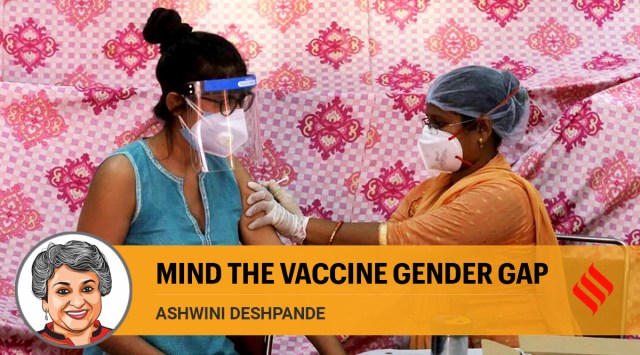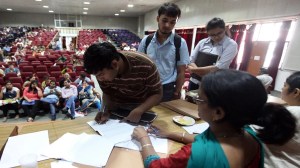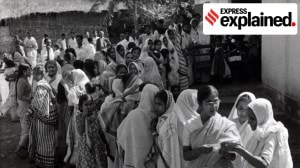- India
- International
As India gets vaccinated, women are falling behind. We must mind this gap
Ashwini Deshpande writes: Mass vaccination can succeed only when we take into account structural inequalities, recognise the specific challenges these impose, and find solutions to circumvent them.
 At a vaccination centre in New Delhi (Express photo/Amit Mehra)
At a vaccination centre in New Delhi (Express photo/Amit Mehra)The second wave of Covid-19 is finally slowing down after tearing through India with a ferocity that the country was tragically underprepared to handle. Given that public health was a low priority item for government expenditure for decades, expecting the medical infrastructure to be ramped up, even though it was urgently needed in the wake of the pandemic, might have been unrealistic. Some might argue that decades of neglect cannot be reversed within months.
But if a radical overhaul was difficult, there were, and continue to be, several interventions that are not at all infeasible, provided there is adequate recognition of the gravity of the problem, a willingness to engage with scientific evidence and the political will to act on immediate recommendations.
When the caseload was low between October 2020 and February 2021, the government could have made productive use of the lull to push for speedy and free mass vaccination, as many experts had recommended. But it did not, because it believed that India had won the war against the pandemic, that India was somehow immune to second waves which had ravaged other countries around the world.
The roll-out was slow and marked by a complicated and inefficient procurement and pricing policy, which threatened to exacerbate inequalities in access to vaccines between states and between the rich and the poor.
After a great deal of tumult and the loss of precious time, the central government has announced a course correction and decided on the central procurement of vaccines. This is long overdue and a welcome move.

As the country gears up towards accelerating the vaccination drive, we need to be mindful of the ground realities that could impede the progress towards mass vaccination. In addition to the slow pace and the abysmally low absolute numbers of people vaccinated, women are getting left behind in the ever-lengthening vaccine queue. At the Centre for Economic Data and Analysis (CEDA), Ashoka University, we have created a moving map that shows the gender gap (female to male ratio) in vaccinations by district each day since vaccinations started (https://bit.ly/3w6vR68).
Till June 3, 2021, this ratio for India was 0.90, which means that 90 women received Covid vaccine doses for every 100 men vaccinated. The vaccination programme was unrolled in phases. Phase 1 started on January 16 and covered all healthcare and frontline workers, a large proportion of whom were women. Subsequent phases opened up vaccine eligibility to different age groups.
The CEDA maps reveal that as vaccination has opened up to the larger sections of the general public, the ratio has declined. In other words, the ratio in the first phase was high because women formed a high proportion of frontline health workers. As citizens are voluntarily getting vaccinated, women are falling behind, which is a matter of concern.
One might legitimately ask whether adopting a gender lens to assess the progress on vaccinations is the right approach when, surely, the overarching aim should be to prevent mortality. This should mean that we should put sections with higher vulnerability to the disease, men or women, young or old, ahead in the vaccine queue. Undoubtedly. However, the problem is that there is no official data for India, sliced by age group, gender, state, rural-urban residence or any other classification, which would help identify these sections accurately, and be a good guide to plan proper targeting.
Analysis of early evidence, based on crowdsourced data, suggests that men have a higher overall burden of the disease, but women have a higher relative risk of Covid-19 mortality in India. A study in Lancet indicates that while globally men are at greater risk of mortality, in some countries (and India is one of them), the case fatality rate is higher among women than men (https://bit.ly/3gqZb0C).
This is subject to data caveats.
In a country with low smartphone penetration, lack of English fluency and a deep digital divide, the logic of making vaccine access conditional on app-based registration is mysterious at best and callous at worst.
Even if these divisions were a secret before March 2020, the first wave definitely unveiled these in too glaring a light to be ignored. It should have been obvious that making access to an English-language smartphone-based app compulsory for getting vaccinated would be a recipe for guaranteed exclusion. Women are seriously disadvantaged, more than men, in being able to meet these conditions and book appointments for themselves.
Finally, when vaccines are not free for all (or there is not a sufficient number of free vaccinations), households that can pay will be ahead of the queue, and within families, men will take priority over women. The evidence on an unequal gendered division of precious resources within families is unambiguous and sadly, shows long-standing and pervasive disparities, whether in the allocation of food, private school or tuition fees, property or asset ownership.
The need of the hour is to ramp up vaccines for all. The abysmally low levels of health infrastructure notwithstanding, India’s record in vaccine production and delivery has been very good. However, mass vaccination can succeed only when we take into account structural inequalities, recognise the specific challenges these impose, and find solutions to circumvent them. The Indian vaccination programme cannot succeed if women are left behind.
This column first appeared in the print edition on June 21, 2021 under the title ‘Mind the vaccine gender gap.’ The writer is professor of economics; director, CEDA, Ashoka University
EXPRESS OPINION
More Explained
Apr 24: Latest News
- 01
- 02
- 03
- 04
- 05










































